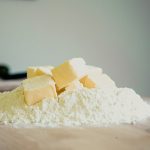Mechanical leavening is a fundamental concept in baking, particularly in the context of biscuits, where achieving the perfect texture is crucial. Unlike chemical leavening, which relies on reactions between ingredients to produce gases, mechanical leavening involves physical processes that create a desirable texture in baked goods. This essay explores the principles of mechanical leavening, its application in biscuit-making, and how heating contributes to the final texture of biscuits.
Understanding Mechanical Leavening
Mechanical leavening involves physical processes that incorporate air into dough or batter, leading to the formation of a light and airy texture. In baking, this process is achieved through various methods:
- Creaming Method:
- Description: The creaming method involves beating fat (usually butter) with sugar until the mixture becomes light and fluffy. This process incorporates air into the fat, which is then distributed throughout the dough or batter.
- Application: When baking biscuits, the creaming method helps to create a tender and flaky texture by trapping air in the fat. This trapped air expands during baking, contributing to the rise and texture of the biscuits.
- Cutting in Fat:
- Description: Cutting in fat involves incorporating cold fat (like butter or shortening) into flour using a pastry cutter, fork, or even your fingers until the mixture resembles coarse crumbs.
- Application: In biscuit-making, cutting in fat creates small pockets of fat within the dough. These pockets melt during baking, releasing steam that contributes to the leavening process and creates layers in the biscuits.
- Folding and Rolling:
- Description: Folding and rolling involve layering and folding the dough to create multiple layers. This technique helps to trap air between the layers, which expands during baking.
- Application: For biscuits, this technique enhances the flakiness and tenderness of the final product by creating distinct layers that separate as the dough bakes.
Mechanics of Heating and Texture Formation
Heating plays a crucial role in the formation of texture in biscuits. Understanding how heat affects the dough helps explain why mechanical leavening methods result in the desired texture. Here’s how heating influences the texture of biscuits:
- Fat Melting:
- Description: As the biscuit dough heats up in the oven, the fat within the dough (butter or shortening) melts. The melting fat creates steam and contributes to the leavening process.
- Effect on Texture: The melting fat helps create a tender texture by separating the layers of dough. As the fat melts, it creates pockets of steam that push against the dough, resulting in a lighter and flakier texture.
- Steam Formation:
- Description: The water content in the dough, including that from the melted fat and any added liquids (such as milk or buttermilk), turns into steam as the temperature rises.
- Effect on Texture: The steam generated during baking causes the dough to expand, creating layers and contributing to the biscuit’s rise. The steam pushes the layers apart, leading to a light and airy texture.
- Starch Gelatinization:
- Description: As the temperature increases, the starches in the flour absorb moisture and swell, a process known as gelatinization.
- Effect on Texture: Gelatinized starches help set the structure of the biscuit, providing support and stability. This contributes to the overall texture and helps maintain the biscuit’s shape.
- Protein Coagulation:
- Description: Proteins in the flour (gluten) and any added ingredients (such as eggs) coagulate as the dough heats up.
- Effect on Texture: Coagulated proteins help give the biscuit structure and strength. They work in conjunction with the gelatinized starches to create a cohesive texture.
Biscuit-Making Techniques and Their Impact on Texture
Several biscuit-making techniques specifically influence the texture through mechanical leavening and heating:
1. Mixing and Handling
- Description: The way you mix and handle biscuit dough affects its texture. Overmixing can develop gluten, leading to a dense and tough biscuit, while undermixing may result in a crumbly texture.
- Impact on Texture: To achieve a tender and flaky biscuit, mix the dough just until combined. Avoid overworking the dough to prevent excessive gluten development, which can make the biscuits tough.
2. Rolling and Folding
- Description: Rolling out the dough and folding it multiple times creates layers in the biscuit dough. This technique is particularly important for achieving a flaky texture.
- Impact on Texture: The layers formed during rolling and folding allow for steam to escape and expand, creating a light and airy texture. The layers separate as the biscuits bake, contributing to their flakiness.
3. Cutting the Dough
- Description: Cutting the biscuit dough into shapes before baking helps ensure even cooking and contributes to the overall texture.
- Impact on Texture: Use a sharp cutter to cut the dough, as a dull cutter can seal the edges and prevent the biscuits from rising properly. The clean cuts allow for better expansion and a more uniform texture.
4. Baking Temperature
- Description: The temperature at which biscuits are baked affects their texture. Baking at too high a temperature can lead to uneven cooking, while too low a temperature may result in undercooked biscuits.
- Impact on Texture: Bake biscuits at a preheated oven temperature (usually around 425°F or 220°C) to ensure even cooking and a consistent rise. The high temperature causes rapid steam formation, contributing to a crisp exterior and tender interior.
The Science Behind Biscuit Texture
Understanding the science behind biscuit texture involves a detailed look at how mechanical leavening and heating work together:
- Air Incorporation:
- Air trapped in the dough through creaming or cutting in fat is crucial for creating a light and airy texture. As the biscuits bake, the trapped air expands, contributing to the rise.
- Fat Melting and Steam:
- The melting fat releases steam, which helps leaven the biscuits and create a tender, flaky texture. The steam also helps separate the layers of dough.
- Gelatinization and Coagulation:
- The gelatinization of starches and coagulation of proteins during baking provide the structural support needed for the biscuits to hold their shape while still being tender.
- Layer Formation:
- Techniques like rolling and folding create layers in the dough. These layers expand during baking, resulting in a flaky texture.
- Baking Temperature:
- The high baking temperature is essential for rapid steam formation and even cooking. It helps achieve a crisp exterior and a tender interior.
Case Study: Classic Biscuit Recipe
To illustrate the principles of mechanical leavening and heating, let’s examine a classic biscuit recipe and how these techniques are applied:
Classic Biscuit Recipe
Ingredients
- 2 cups all-purpose flour
- 1 tablespoon baking powder
- 1/2 teaspoon salt
- 1/2 cup cold unsalted butter, cubed
- 3/4 cup milk (or buttermilk)
Preparation:
- Preheat Oven:
- Preheat your oven to 425°F (220°C).
- Prepare Dry Ingredients:
- In a large mixing bowl, whisk together the flour, baking powder, and salt.
- Cut in Butter:
- Add the cold butter to the dry ingredients. Using a pastry cutter or fork, cut the butter into the flour mixture until it resembles coarse crumbs. This process incorporates air into the dough and creates pockets of fat.
- Add Milk:
- Gradually add the milk to the mixture, stirring until just combined. The milk hydrates the flour and helps bind the dough.
- Roll and Fold:
- Turn the dough out onto a lightly floured surface. Gently roll the dough to about 1/2-inch thickness. Fold the dough over itself a few times to create layers.
- Cut and Bake:
- Using a biscuit cutter, cut the dough into rounds and place them on a baking sheet lined with parchment paper. Bake in the preheated oven for 12-15 minutes, or until golden brown.
Texture Analysis:
- Creaming Method: The cutting in of cold butter helps create layers in the dough, resulting in a flaky texture.
- Steam Formation: The milk and melted butter generate steam during baking, contributing to the rise and light texture of the biscuits.
- Starch Gelatinization and Protein Coagulation: The flour’s starches and proteins provide structure and stability, supporting the biscuit’s shape.
Practical Tips for Perfect Biscuits
- Use Cold Ingredients:
- Cold butter and chilled milk help create a flakier texture by preventing the fat from melting too quickly before baking.
- Avoid Overmixing:
- Mix the dough just until combined to avoid developing too much gluten, which can result in tough biscuits.
- Handle the Dough Gently:
- Be gentle when rolling and cutting the dough to maintain the layers and avoid compacting the dough.
- Preheat the Oven:
- Ensure the oven is fully preheated to achieve the desired rise and texture.
- Experiment with Techniques:
- Try different techniques and recipes to find the method that produces the best texture for your taste preferences.
Mechanical leavening plays a crucial role in biscuit-making, contributing to the desired texture through physical processes like air incorporation and fat melting. Heating further influences the texture by generating steam, gelatinizing starches, and coagulating proteins. By understanding these principles and applying appropriate techniques, you can create biscuits with a light, tender, and flaky texture that highlights the art and science of baking.
Through careful manipulation of ingredients and techniques, you can master the perfect biscuit texture, achieving a delicious result that exemplifies the principles of mechanical leavening and heating.


Leave a Reply